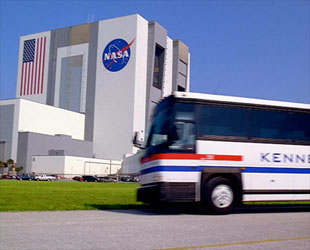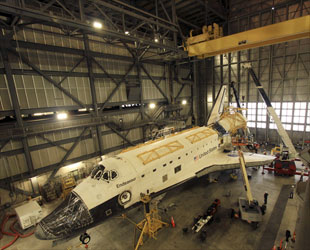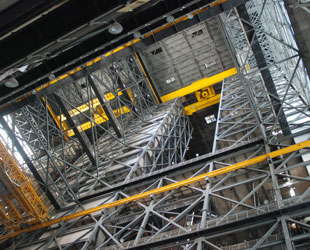October 24, 2011 — With no more space shuttles to build up for launch and years to go before its next-generation heavy-lift rocket is ready to fly, NASA is reopening its 52 story Vehicle Assembly Building to the public after more than three decades of it being closed for general tours.
Beginning next month, visitors to NASA's Kennedy Space Center in Florida will be able to purchase tickets for a new "Up-Close" tour, which in addition to busing spectators to see launch pads and other facilities around the spaceport, will take them in the Vehicle Assembly Building, or VAB.
The huge building – the largest single-story structure and the fourth largest by volume in the world — was used for 30 years to stack shuttle orbiters with their boosters and fuel tanks for 135 missions. Before then, the building's original use was to assemble the stages that formed the 363-foot Saturn V rockets that launched Apollo astronauts to the moon.

| Starting Nov. 1, visitors to Kennedy Space Center will be able to do more than just drive by the Vehicle Assembly Building. (KSC) |
The building, its side adorned with a painted U.S. flag so large that a city bus could fit within any one of its red and white stripes, has attracted tourists since it was built in 1966. But since 1978, spectators have had to settle for an outside view only as the solid fuel in the shuttle's boosters made the building too dangerous to allow in large groups of visitors.
With the
shuttle program over, the Kennedy Space Center Visitor Complex (KSCVC) is now able to offer limited daily tours to bring their guests into the VAB.
Shuttle sighting
Once inside the 525-foot tall Vehicle Assembly Building, tour-goers will walk along the edge of the transfer aisle, a 700-foot long corridor that divides the voluminous hangar's north and south sides. The aisle was used to move the behemoth segments of Saturn rockets and space shuttles among the four high bays within the building.
It is within one of these high bays that some visitors may still spot one of NASA's retired shuttles waiting inside the VAB to be readied for its public display.

| Space shuttle Endeavour temporarily parked inside High Bay 4 of the Vehicle Assembly Building as seen last month. (NASA) |
With three orbiters to prepare – Discovery, Endeavour and Atlantis – and only two operational processing facilities, the space center has taken to temporarily parking one of the shuttles in the VAB. At current, Endeavour is inside High Bay 4, but it is expected to trade places with another orbiter soon.
Beginning next year, NASA will
start shipping the orbiters out to their respective museums, with Discovery slated as the first to leave in April. The shuttle encounter inside the VAB will therefore be available for a limited time only.
Signs of things to come
Even without the rare shuttle sighting, spectators will find plenty to see inside the building.
Tour guides will provide overviews of the the work done in the VAB, and colorful signage will offer tourists a view of the past engineering feats that have taken place behind the 456-foot-tall high bay doors, such as the work of the building's two 325-ton bridge cranes that were used to
lift the shuttle orbiters and mate them to their external tank and boosters with pinpoint accuracy.

| The largest single-story building, the Vehicle Assembly Building (VAB) offers an interior view 525 feet straight up. (collectSPACE) |
Visitors will also preview the planned operations that will take place in the coming years to support NASA's next space exploration program, the Space Launch System, or SLS. The Congressionally-authorized heavy-lift rocket and its multi-purpose crew vehicle (MPCV) – which when fully assembled will tower as tall, if not taller than the Saturn V – is being developed to launch astronauts on exploration missions out into the solar system.
Outside the VAB
Going inside of the Vehicle Assembly Building may be the highlight of the new "KSC Up-Close" bus tour, but it is not its only stop.
Set to begin Nov. 1 and run eight times daily, the tour will begin with guests seeing other KSC landmarks including the center headquarters and the Operations and Checkout (O&C) building, which houses the astronaut crew quarters used prior to each launch and where space hardware was tested before flight. The O&C is also the site from which astronauts boarded the Astrovan for the launch pads.
The tour will also drive by the Space Station Processing Facility, where the components that fit together in orbit to build the International Space Station were processed and tested before launch.
Next, guests will be taken to the NASA Causeway for a panoramic view of the Banana River, Port Canaveral and Cape Canaveral Air Force Station, home of the first rocket launches for 1960's Mercury and Gemini programs. Tour participants will be able to spot launch pads 17, 37, 40, and 41, which are still in use for both commercial and government launches. They may even spot rockets on the pads or inside their mobile service structures.
From this vantage point, spectators may also see Liberty Star and Freedom Star, the two recovery ships used to retrieve the space shuttle's reusable solid rocket boosters from the Atlantic Ocean after they were jettisoned during each launch.
Crawlers, the countdown clock and more
The tour will then travel past the three orbiter processing facilities (OPFs), the hangars where shuttle orbiters were processed and maintained between flights. Today, two of the OPFs are being used to decommission the orbiters in preparation for their retirement, including Atlantis, which will be displayed in a $100 million facility at the Kennedy Space Center Visitor Complex in 2013.
Following a stop inside the VAB, tour-goers will re-board their bus for views of the massive crawler transporters and "crawlerway," the equivalent of an eight-lane highway lined with river rock and designed to support the crushing weight of the Saturn V and space shuttles along with their mobile launch platforms.
They'll also get a view of the solid rocket booster storage areas; the Pegasus barge used to haul shuttle external tanks from their assembly facility in Louisiana; the NASA Press Site with its iconic large countdown clock; as well as the Shuttle Landing Facility (SLF) and its Mate/Demate Device, where orbiters were unloaded from Boeing 747s after an occasional cross-country piggyback ride.
Finally, the tour will give guests the chance to see Launch Pads 39A and
39B from one of the hilltop sites from which NASA remotely captured launch imagery.
Ticket to ride
The two-hour "KSC Up-Close" tour, which is one of two special-interest tours being offered by the Kennedy Space Center Visitor Complex, will require an additional ticket to ride.
The new tour with its access inside the Vehicle Assembly Building will run visitors $25 per adult and $19 for children (ages 3-11), in addition to the normal cost of admission to the Visitor Complex.
Due to the anticipated popularity of the new tour, Visitor Complex officials advise that advance reservations are "strongly suggested."
To book the Up-Close tour, visit kennedyspacecenter.com or call 866-737-5235. 